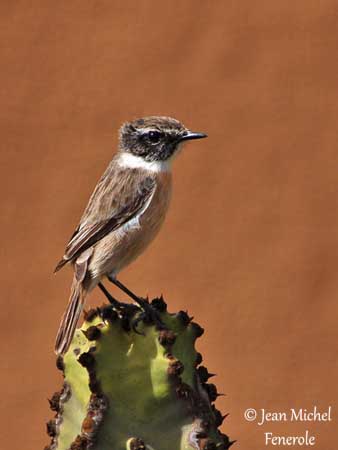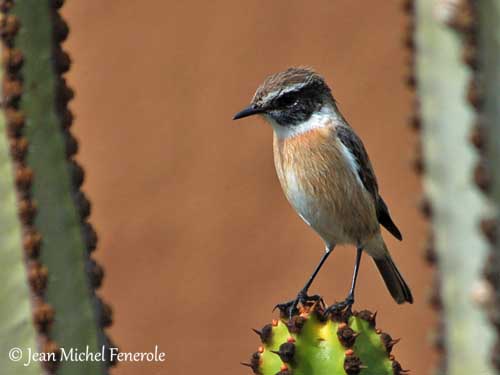
Fr: Tarier des Canaries
All: Kanarenschmätzer
Esp: Tarabilla Canaria, Tarabilla Isleña
Ita: Saltimpalo delle Canarie
Nd: Canarische Roodborsttapuit
Sd: Kanariebuskskvätta
Photographer:
Jean Michel Fenerole
Photos d’Oiseaux du monde
Text by Nicole Bouglouan
Sources:
HANDBOOK OF THE BIRDS OF THE WORLD Vol 10 by Josep del Hoyo-Andrew Elliott-David Christie - Lynx Edicions - ISBN: 8487334725
BirdLife International (BirdLife International)
Enciclopedia virtual de los vertebrados españoles
Wikipedia, la enciclopedia libre
Canary Islands Stonechat
Saxicola dacotiae
Passeriformes Order – Muscicapidae Family
INTRODUCTION:
The Canary Islands Stonechat is a monotypic species, endemic to Canary Islands, and especially to Fuerteventura Island. It is threatened by habitat destruction due to human developments for tourism.
DESCRIPTION OF THE BIRD:
Biometrics:
Length: 11-12 cm
The adult male has blackish head with narrow, white supercilium. Chin and throat are white, extending around the ear-coverts and forming a white half-collar.
The upperparts are brown streaked black, but the rump is mostly grey. Wings and tail are dark brown.
On the underparts, we can see a variable rufous-orange area on the breast. Rest of underparts is dull white, with white undertail-coverts.
The bill is blackish. The eyes are dark brown. Legs and feet are black.
The male in fresh plumage has browner upperparts and pale greyish-brown rump. The white areas are less extensive. The underparts are rufous-orange.

The adult female is paler and greyer than male. The upperparts are dark brown streaked dark, and the rump is greyish. The underparts are creamy-buff.
On the brownish head, the weak supercilium is buffy-white.
In fresh plumage, she is paler and greyer above with yellowish-brown rump, whereas the underparts are buffier.
The juvenile resembles female in fresh plumage. The upperparts are streaked buff. The breast shows black stippling.
RANGE:
The Canary Islands Stonechat is found on Fuerteventura Island, in E Canary Islands.
HABITAT:
The Canary Islands Stonechat frequents rocky areas such as rocky hillsides and ravines (barrancos) with shrubby vegetation cover. It can be seen at the edges of vegetated lava flows, in cultivated areas and gardens, and in dry and flowing ravines.
It forages on earthy and stony fields which provide this species numerous invertebrates, but also nesting sites.
CALLS AND SONGS: SOUNDS BY XENO-CANTO
The song of the Canary Islands Stonechat male resembles that of the European Stonechat. The territorial song is produced only by the male at the beginning of the breeding season. This is a scratchy “bik-bizee-bizeeu”, but variants are also uttered. In flight, the song is a combination of soft and loud rasping notes such as “liu” and “screeiz”, giving the phrase “liu-liu-liu screeiz”
The contact call is a dry “tak” or “chak”. The alarm call is a whistled “seit” or “suit”, and a harsh “chup” in extreme anxiety.
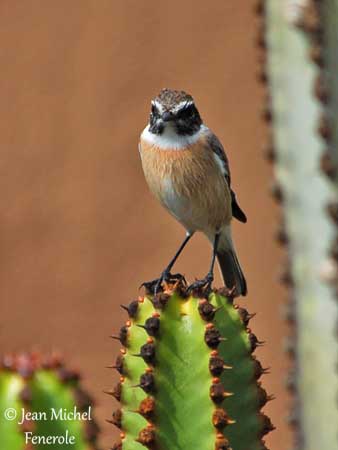
BEHAVIOUR IN THE WILD:
The Canary Islands Stonechat feeds mainly on numerous invertebrates such as caterpillars, ants, flies, centipedes, beetles and spiders.
It hunts from a perch and flies down to the ground, or catches flying preys by sallying into the air. On the ground, it pursues the preys by hopping and running.
It forages in stony areas and ravines, but it avoids lava flows and sandy fields. It may occasionally take some fruits and berries.
Males begin to sing as soon as the autumn and winter rains start. They strongly defend the territory and usually, females help them. Intruders are chased away from the area, and mainly insect-eaters such as the Berthelot’s Pipit, or migratory species such as the Black Redstart.
The Canary Islands Stonechat is monogamous. Courtship displays by male occur at the beginning of the breeding season. It flicks its tail and then, it flies towards the female. In response, she also flicks her tail and hops about.
The male bows forwards with the bill pointed downwards, in order to expose the black-and-white plumage pattern of the neck. These displays are followed by a fluttering flight just above the ground by both mates.
Then, the female selects a nest-site and builds the nest, accompanied by the male, but it does not help.
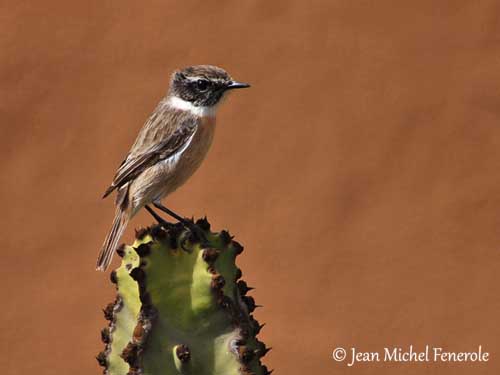
The Canary Islands Stonechat is sedentary in its range. However, old reports of 1913 mention this species in Alegranza and Montaña Clara in N Lanzarote Island. These reports may indicate some dispersion from Fuerteventura.
Outside the breeding season, this species can be seen alone or in pairs, but also in small loose groups of adults and juveniles.
The flight is agile, and the bird is able to catch flying insects in the air.
REPRODUCTION OF THIS SPECIES:
The breeding season is related to the rains, and often takes place between January and late March, but the laying may also start in December according to the rains. The wet winters may sometimes involve a second brood.
The nest is built by the female. This is a cup-shaped nest made with woven twigs for the base, and plant stems and roots. It is lined with goat hair and sheep wool, and sometimes feathers.
It is placed among stones and rocks on sloping ground, or in cactus thicket, under vegetation such as shrub or clump of grasses, but also low down (-50 cm) in the wall of a ravine. In this case, some overhanging vegetation or rock shelters the site.
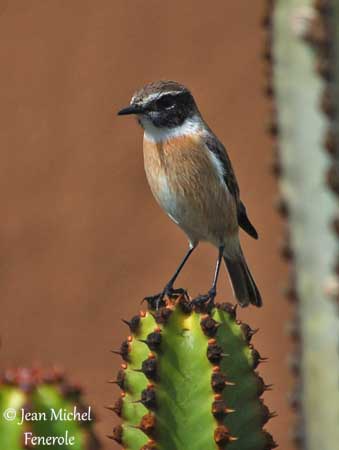
The female lays 3-5 pale blue-green eggs with fine dark markings. She incubates alone during 16-18 days. The chicks are fed by both adult’s with insects. They fledge 14-20 days after hatching, and still depend on adults for one month.
PROTECTION / THREATS / STATUS:
The Canary Islands Stonechat is preyed upon by the Southern Grey Shrike and the Common Kestrel and sometimes by the Eurasian Buzzard and the Barn Owl too. The nests are destroyed by introduced cats and rats.
The main threats are the human developments such as tourist and residential centres and new roads which destroy the habitat of this species. Cattle and goats accelerate the desertification by reducing the vegetal cover, involving less food availabilities.
The high fidelity of this species to its sites exacerbates this problem.
The Canary Islands Stonechat is currently listed as Near Threatened, with a population estimated at 8900/10,000 mature individuals.
